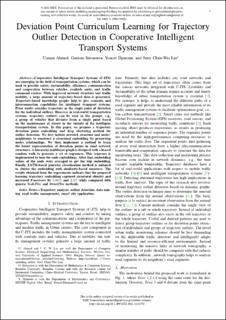| dc.description.abstract | Cooperative Intelligent Transport Systems (C-ITS) are emerging in the field of transportation systems, which can be used to provide safety, sustainability, efficiency, communication and cooperation between vehicles, roadside units, and traffic command centres. With improved network structure and traffic mobility, a large amount of trajectory-based data is generated. Trajectory-based knowledge graphs help to give semantic and interconnection capabilities for intelligent transport systems. Prior works consider trajectory as the single point of deviation for the individual outliers. However, in real-world transportation systems, trajectory outliers can be seen in the groups, e.g., a group of vehicles that deviates from a single point based on the maintenance of streets in the vicinity of the intelligent transportation system. In this paper, we propose a trajectory deviation point embedding and deep clustering method for outlier detection. We first initiate network structure and nodes' neighbours to construct a structural embedding by preserving nodes relationships. We then implement a method to learn the latent representation of deviation points in road network structures. A hierarchy multilayer graph is designed with a biased random walk to generate a set of sequences. This sequence is implemented to tune the node embeddings. After that, embedding values of the node were averaged to get the trip embedding. Finally, LSTM-based pairwise classification method is initiated to cluster the embedding with similarity-based measures. The results obtained from the experiments indicate that the proposed learning trajectory embedding captured structural identity and increased F-measure by 5.06% and 2.4% while compared with generic Node2Vec and Struct2Vec methods. | en_US |
